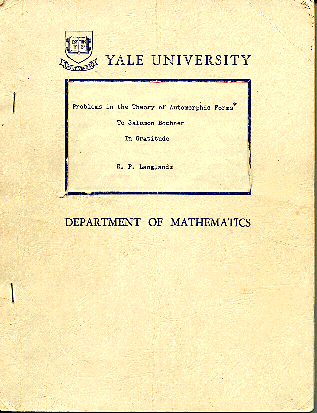Problems in the Theory of Automorphic Forms
Lectures in modern analysis and applications III, Lecture Notes in Mathematics . 170 (1970)

Editorial comments: The conjectures made in the 1967 letter to Weil were explained here more fully. This appeared originally as a Yale University preprint, later in the published proceedings of a conference in Washington, D.C. Lectures in modern analysis and applications III, Lecture Notes in Mathematics 170, Springer-Verlag, 1970. The lecture is dedicated to Salomon Bochner.
Author's comments: The lecture in Washington, D.C. on which these notes were based (they were presumably written shortly thereafter) was, I surmise, delivered sometime in 1969, thus more than two years after the letter to Weil. They were the first published account of the conjectures made in the letter. In the meantime, a certain amount of evidence had accumulated.
The letter had been written, I believe, only a few days or at most weeks after the discoveries it describes. They were not mature. The local implications appear not to have been formulated, and the emphasis is not on the reciprocity laws as a means to establish the analytic continuation of Artin \(L\)-functions but on concrete, elementary laws, for which groups other than \(\mathrm{GL}(n)\) are important because they admit anisotropic \(\mathbf R\)-forms. The coefficients of automorphic \(L\)-functions attached to groups anisotropic over \(\mathbf R\) can be interpreted in an elementary way as in A little bit of number theory. In addition, I was not aware of Weil's paper on the Hecke theory or of the Taniyama conjecture. Indeed, not being a number theorist by training (and perhaps not even by inclination) I was well-informed neither about Hasse-Weil \(L\)-functions nor about elliptic curves.
After the letter had been transmitted, I learned from Weil himself both about his paper and about the Weil group. This is implicit in the lecture and accounts in part for its greater maturity. First of all, encouraged by Weil's re-examination of the Hecke theory, Jacquet and I had developed a theory for \(\mathrm{GL}(2)\) with some claims to completeness both locally and globally, although at both levels the major questions about reciprocity remained unanswered. With the local theory for \(\mathrm{GL}(2)\) came \(\epsilon\)-factors and the correspondence of the letter then required that such factors also exist for Artin \(L\)-functions. One achievement of a year spent in Turkey was the proof that these \(\epsilon\)-factors exist. One achievement of the following year, accomplished in collaboration with Jacquet, was a complete proof of the correspondence between automorphic forms on \(\mathrm{GL}(2)\) and on quaternion algebras. This correspondence had, of course, already appeared classically. Our achievement was, I believe, local precision, in particular the understanding that there were local phenomena of importance, and generality.
Although specific attention is drawn in the lecture to the case that \(G'\) is trivial and the automorphic \(L\)-functions attached to it therefore nothing but Artin \(L\)-functions, it is not at all stressed that functoriality entails the analytic continuation of the Artin \(L\)-functions. It is of course evident, but I had not yet learnt the advantages of underlining the obvious. The other examples of functoriality may or may not appear well-chosen to a number theorist in 1998. In 1967, however, it was rather agreeable to see the recently established analytic theory of Eisenstein series fitting so comfortably into a conjectural framework with much deeper arithmetical implications.
The question about elliptic curves appearing toward the end of §7 is nothing but a supplement to the conjecture of Taniyama-Shimura-Weil, but a useful one: a precise local form of the conjecture, that is now available, thanks to Carayol and earlier authors, whenever the conjecture itself is. At the time, what was most fascinating was, as mentioned in the comments on the letter to Serre, the relation between the special representation and the \(\ell\)-adic representations attached to elliptic curves with nonintegral \(j\)-invariant.
The observation about \(L\)-functions and Ramanujan's conjecture has, I believe, proved useful.